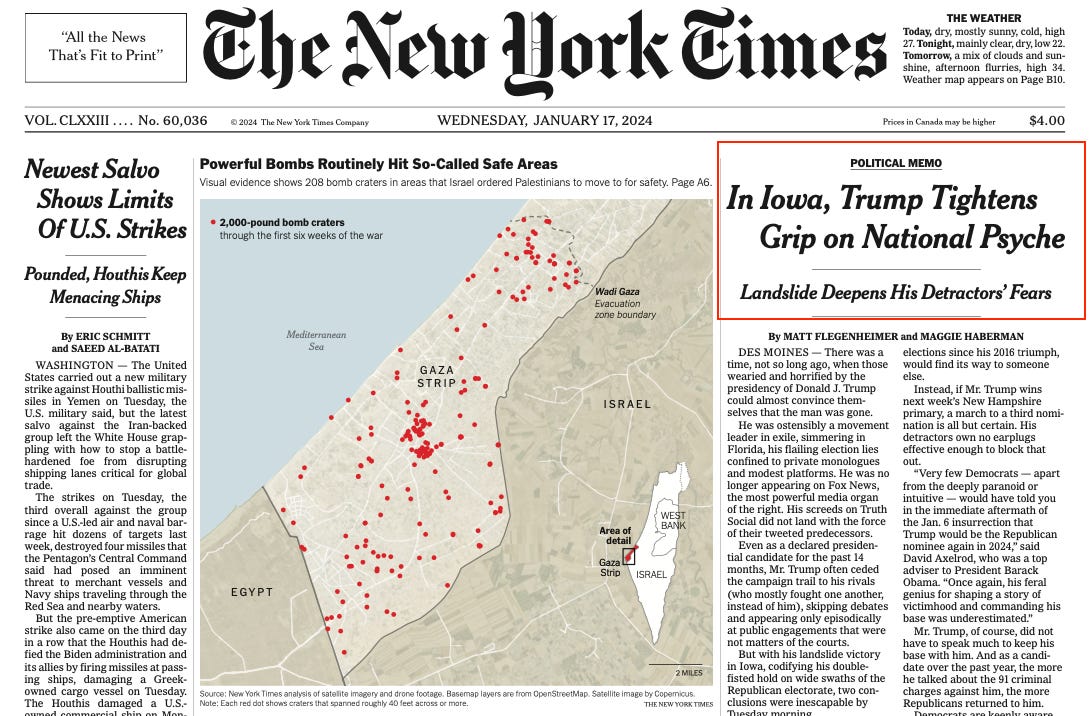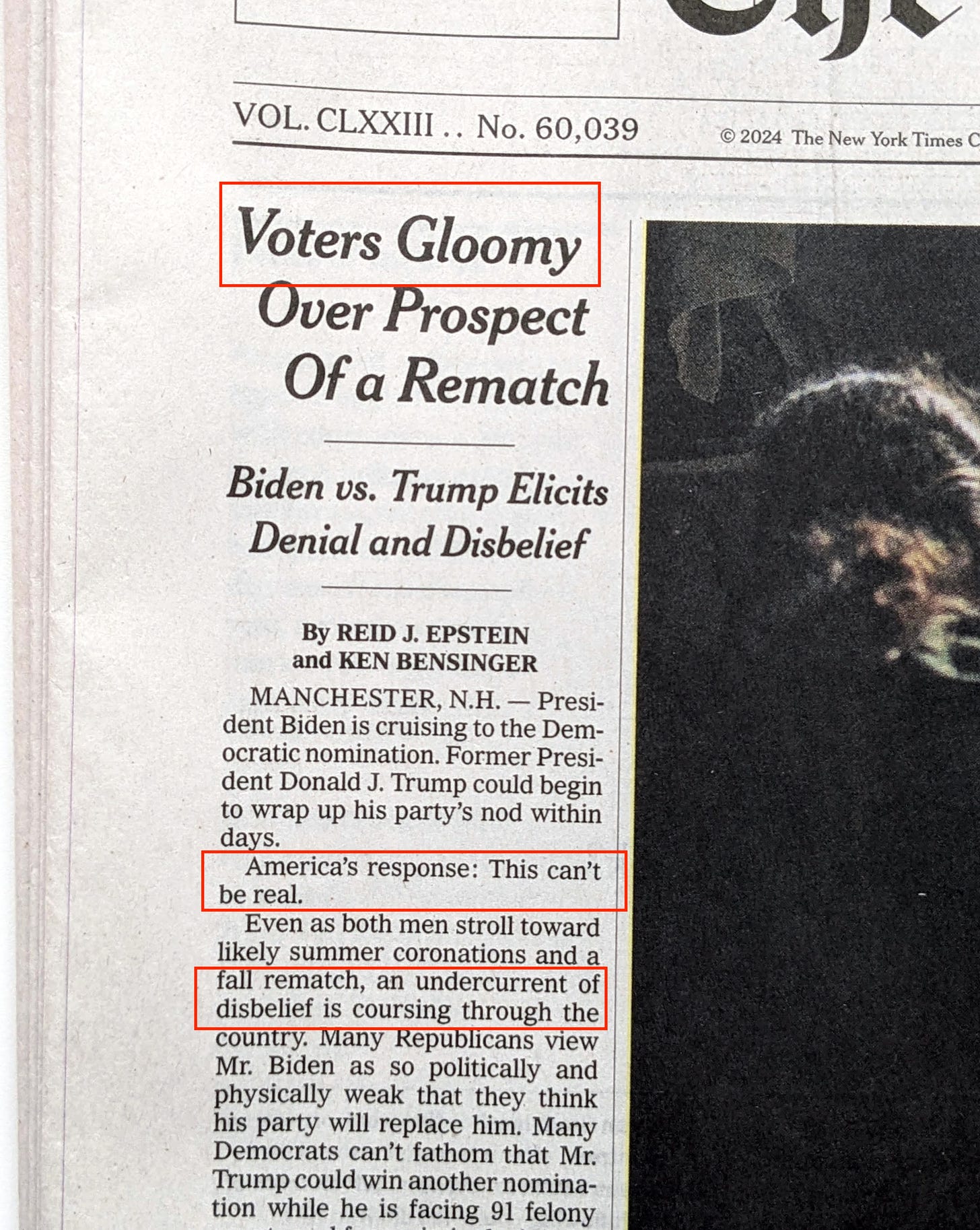Election Countdown, 291 Days to Go: Our Country's Story, Told in Headlines
The press as a whole tells us about our country. The political press is telling us about itself.
UPDATE as of January 20, one year before the next inauguration day.
The top of today’s NYT front page has this story, which illustrates exactly what I am talking about in the rest of this post from last night. Here is the new story’s play on the front page:
For context with the discussion below: There is a striking gap between hyper-cautious “detractors contend” or “could give rise to questions” treatment of many aspects of political news, including threats from and offenses by Donald Trump, on the one hand, and this kind of sweeping pronouncement about what “America” thinks on the other. This is what I discuss below.
One other update: my friend Paul Glastris of The Washington Monthly, whose excellent recent article I recommended in the original post, reminds me of an important point in a WSJ story whose headline I mentioned. That story, by Gwynn Guilford and Amara Omeokwe, discussed signs of a brightening public mood about the US economy. It included this paragraph about the media’s role:
Media coverage might be rubbing off on consumers, too. The mood of economy-related articles has rebounded since November to the highest level since 2018, according to the San Francisco Fed’s Daily News Sentiment Index. Coverage had skewed much more negatively in the past three years relative to economic fundamentals, a Brookings Institution analysis found.
Again, concerns about economic fairness and opportunity are real, and not invented by the media. But the tone of press coverage has played a part.
Now, back to the original post:
What our headlines tell us.
There’s no chance that future historians will try to understand the 2020’s by leafing through musty bound volumes of our daily newspapers. That’s because such volumes won’t exist. I realize that I am a quaint outlier in still paying to get printed papers every morning at our house.1
But among the reasons I like seeing physical newspapers2 is that their layout reflects such a highly evolved set of signals, beyond what is simply written down. You can tell so much about a story through a headline, from an unusual or splashy layout, from a photo, through the unspoken language of placement on a page.3 These cues give you “situational awareness” about what the editors consider more and less important, what is truly urgent and what is merely interesting, what is connected to other stories and what stands alone.
The rest of this post will be a set of screen-shot headlines, which together might be in a historian’s scrapbook of the United States early in this re-election year. I’ll try to pare down the commentary and hope that the pictures do most of the talking.
1) ‘Tightens Grip on National Psyche’
The image at the top of this post is the front page of the NYT, 36 hours after Donald Trump won 51% of the vote in the Iowa caucuses.
The Iowa results could be read two ways. First, from Trump’s point of view, and that of some instant-analysis recaps, they were a landslide victory. He got more votes than the rest combined! And the diffidence of his opponents, plus the silence of party leaders about his legal and other problems, shows that the party will line up behind him if he is the nominee.
But from a “let’s think about November” perspective, and that of many second-day analyses, the Iowa results underscored the limits of Trump’s appeal. He has a stronger and stronger hold, on a smaller and smaller base. Trump is never going to find an electorate more favorable and MAGA-minded than this week’s in Iowa—mainly white, older, rural, religious. Yet even among them, turnout was low (albeit in bad weather), and nearly half voted for someone else. Some 56,000 people chose Trump in this “landslide.” Or about one-fifteenth as many as live in my current home town of Washington DC.
Yet in its second-day analysis, the country’s most influential publication led its front page with its conclusion that Trump had tightened his “grip on the national psyche,” as highlighted.4
I note this for a couple of reasons.
One involves “projection.” Donald Trump’s attacks often boil down to projection—accusing other people of what he’s most guilty of himself.
I think a kind of projection/“tell” comes with this headline. The spectacle of Trump has “tightened its grip” not so much on the country’s psyche as on that of the political-news establishment. For the rest of us, I think Trump is a reality but not an obsession.
For additional context, this was the NYT’s front-page piece just one day before the Iowa election:
I think the right-hand piece shows papers like the Times at their best. The left-hand piece tells us in its headline about “Bipartisan Dread,” and in its text that voters “casually talk of the prospect of World War III, civil unrest, and a nation coming apart at the seams.”
The paper’s confidence and certainty in telling us about “bipartisan dread” leads us to the next item on the list:
2) ‘Seeming Contradiction’
One of the mysteries of the modern press is the judgments reporters can make on their own, versus others consigned to “critics contend” and “detractors would say.”
—On its front page, with no “sources say” caveating, the NYT tells us that Trump has “tightened his grip on the national psyche.”
—But also on its front page, in a reported story just days earlier, the same paper carefully hedged its judgments about the Trump-team’s universally ridiculed “SEAL Team Six” appeals-court argument. From the story:
Back during the 2000 election campaign, I taught a course at a journalism school. For anyone doing so in 2024, I suggest one session based on these pieces: What things you can simply assert as true, and which only “appear” to have happened.
For bonus reading in that course: the Times editors gave the go-ahead to this recent pronunciamento on the mind of the nation as a whole:
3) Meanwhile, not quite gripping our psyche…
Here is a pastiche of other recent headlines by reporters not directly covering politics, but who I think are telling us more about the political/ social currents of our times.








